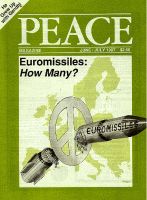
Peace Magazine Jun-Jul 1987, page 21. Some rights reserved.
Search for other articles by Stathis Stathopoulos here
THE SOVIET UNION IS ON A PEACE OFFENSIVE. Less than a year has passed since Mikhail Gorbachev offered historic, all-embracing proposals that envisioned a nuclear weapons-free world by the year 2000. The Reykjavik Summit could have taken a big step toward this goal, but didn't. The West has maintained a stance of “cautious enthusiasm" in response to the many Soviet initiatives. However, this is usually the preface for a rejection, a cover for hidden intentions that an outright refusal would expose.
The Soviet proposals are as follows:
1. The Zero-Zero option for middle-range missiles stationed in Eastern and Western Europe, and separate discussions on mid-range missiles in Asia. This is the famous U.S. "Zero Option" proposal, to which the Soviet Union has dropped its original opposition, even though the proposal leaves French and British nuclear intermediate-range missiles in place, aimed at the Soviet Union and still part of the NATO force. In fact, France just approved the biggest budget ever to upgrade its nuclear force.
The situation is asymmetrical. While Soviet mid-range missiles are only effective against Europe, NATO missiles can hit all the Warsaw Pact countries including the Soviet Union. Although these are intermediate-range missiles, they can destroy strategic Soviet centres. To the Soviets they might as well be long-range ballistic missiles.
Used in such short distances, these swift Pershing IIs and evasive cruises are dangerous weapons against the Soviet Union. They have first strike capability and help foster the illusion that the U.S. could win a nuclear war. On the other hand, while the Soviet missiles could hit their targets in Western Europe, the U.S. would not be immediately affected and hypothetically could continue a war!
Thus from a technical military viewpoint, the Soviets are not only offering great compromises, but are even assuming certain risks, considering the number of U.S. nuclear-equipped aircraft carriers in the Mediterranean and North Atlantic. In addition, the Soviets are facing nuclear weapons stationed in Greece (see Washington Report by W. Arkin, Bulletin of Atomic Scientists, March 1987), in Turkey, and possibly in Italy. There is also evidence that bases are being prepared in the Turkish occupied part of Cyprus, effectively making this part of NATO.
2. The Soviet Union has also dropped its insistence that an agreement on mid-range missiles be coupled with Star Wars. This is another major compromise. They obviously hope that political gains will help offset the techno-military disadvantages.
3. To deal with shorter range (500-1000 km) weapons, the Soviets initially proposed separate talks.
The West claims it has no short range missiles in Europe, therefore it says it must reject the Soviet proposal. To do otherwise would leave Europe vulnerable.
This is a lie; NATO has both short range and battlefield weapons in Europe and it had them before the Soviets. For its part, NATO has proposed converting its mid-range missiles into shorter range nuclear weapons. Herein lies a trick. Since these weapons have been designed for longer range activity they can quickly be converted back.
The final argument is over the mythical superiority of the Warsaw Pact conventional forces. L. Lapham put this argument to rest on April 22 in the Globe and Mail, citing Tom Gervasi's The Myth of Soviet Military Supremacy, which shows that the Warsaw Pact countries have neither numerical superiority nor qualitative advantage.
The Soviets have made additional proposals dealing with conventional forces and chemical weapons. Obviously, the Soviets are making an honest and intense effort to overcome the arms race crisis. Moreover, they have been self-critical about their past arms negotiation stance, openly admitting that for a certain period they had been trapped in the "mutual assured destruction" mentality.
During the past two years, Soviet thinking has taken a radical new turn. Starting from the premise that no one can win a nuclear war and from the scientific fact that a strike from one side would be sufficient to destroy both the attacked and the attacker, (because of "nuclear winter" and other related effects) the Soviet leadership has issued a call for a "new way of thinking" in our nuclear age. This new way includes recognizing that no one has a right to destroy this planet. The Communists are telling the world that nothing, especially ideology or choice of economic system, comes ahead of survival. This is a challenge for the capitalist world. Can it live in peaceful coexistence, even in peaceful antagonism with socialism, or will it keep humanity at the precipice for the sake of profits? Canada should contribute by convincing the West to pursue the former alternative. The Canadian peace movement's campaign to "vote Canada out of the arms race," can produce the pressure to move our government in this direction.
Stathis Stathopoulos is chairperson of the Peace Committee, Communist Party of Canada.

Peace Magazine Jun-Jul 1987, page 21. Some rights reserved.
Search for other articles by Stathis Stathopoulos here